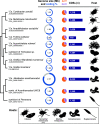The "Other" Rickettsiales: an Overview of the Family " Candidatus Midichloriaceae"
- PMID: 35108076
- PMCID: PMC8939350
- DOI: 10.1128/aem.02432-21
The "Other" Rickettsiales: an Overview of the Family " Candidatus Midichloriaceae"
Abstract
The family "Candidatus Midichloriaceae" constitutes the most diverse but least studied lineage within the important order of intracellular bacteria Rickettsiales. "Candidatus Midichloriaceae" endosymbionts are found in many hosts, including terrestrial arthropods, aquatic invertebrates, and protists. Representatives of the family are not documented to be pathogenic, but some are associated with diseased fish or corals. Different genera display a range of unusual features, such as full sets of flagellar genes without visible flagella or the ability to invade host mitochondria. Since studies on "Ca. Midichloriaceae" tend to focus on the host, the family is rarely addressed as a unit, and we therefore lack a coherent picture of its diversity. Here, we provide four new midichloriaceae genomes, and we survey molecular and ecological data from the entire family. Features like genome size, ecological context, and host transitions vary considerably even among closely related midichloriaceae, suggesting a high frequency of such shifts, incomplete sampling, or both. Important functional traits involved in energy metabolism, flagella, and secretion systems were independently reduced multiple times with no obvious correspondence to host or habitat, corroborating the idea that many features of these "professional symbionts" are largely independent of host identity. Finally, despite "Ca. Midichloriaceae" being predominantly studied in ticks, our analyses show that the clade is mainly aquatic, with a few terrestrial offshoots. This highlights the importance of considering aquatic hosts, and protists in particular, when reconstructing the evolution of these endosymbionts and by extension all Rickettsiales. IMPORTANCE Among endosymbiotic bacterial lineages, few are as intensely studied as Rickettsiales, which include the causative agents of spotted fever, typhus, and anaplasmosis. However, an important subgroup called "Candidatus Midichloriaceae" receives little attention despite accounting for a third of the diversity of Rickettsiales and harboring a wide range of bacteria with unique features, like the ability to infect mitochondria. Midichloriaceae are found in many hosts, from ticks to corals to unicellular protozoa, and studies on them tend to focus on the host groups. Here, for the first time since the establishment of this clade, we address the genomics, evolution, and ecology of "Ca. Midichloriaceae" as a whole, highlighting trends and patterns, the remaining gaps in our knowledge, and its importance for the understanding of symbiotic processes in intracellular bacteria.
Keywords: Euplotes; Rickettsiales; endosymbionts; “Candidatus Anadelfobacter”; “Candidatus Bandiella”; “Candidatus Cyrtobacter”; “Candidatus Grellia”; “Candidatus Midichloriaceae”.
Conflict of interest statement
The authors declare no conflict of interest.
Figures




References
-
- Montagna M, Sassera D, Epis S, Bazzocchi C, Vannini C, Lo N, Sacchi L, Fukatsu T, Petroni G, Bandi C. 2013. “Candidatus Midichloriaceae” fam. nov. (Rickettsiales), an ecologically widespread clade of intracellular alphaproteobacteria. Appl Environ Microbiol 79:3241–3248. 10.1128/AEM.03971-12. - DOI - PMC - PubMed
Publication types
MeSH terms
LinkOut - more resources
Full Text Sources

